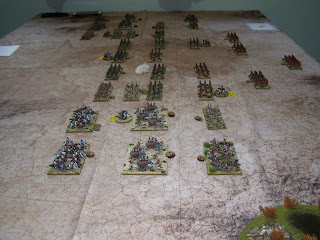As so often seen on this blog, I go in cycles with my interest in wargaming history. I am glad at least that I always return back to favourite periods and nothing 'drops off' permanently. I do find that it is also seasonal.
For some reason, in the summer I tend to paint and read up either about the English Civil War or the Normandy campaign. Perhaps it is because for over a decade, I spent weekends re-enacting the Civil War and it was almost always in the summer. In the summer the high overgrown hedges in the country lanes do often bear similarities to the newsreel footage of the bocage in 1944.
I have long been interested by the battle for Hill 112 in Normandy. This was prompted by a book I bought as a teenager. The book was 'Hill 112' by Major JJ Howe MC. It is a book I take down from my book case very often. I discovered in 2004 at my Great Grandmother's funeral that one of her brothers was there in the battle for Hill 112 with 5th Battalion Duke of Cornwall's Light Infantry. I was told this by my Great Great Uncle (another brother of my Great Grandmother), who himself had been in the DCLI and then the Kings Regiments (and had been at Dunkirk and the whole of the siege of Malta). So for this reason also, I wanted the unit to be part of 5 DCLI, 43 Wessex Division.
Once the unit decision was made, it was a case of researching badges and finding photos on-line. I learned a lot about the unit markings. Unfortunately I couldn't find a company who made 15mm decals for the Wessex Division or the appropriate numbering so I hand painted these on the carriers. This didn't turn out too badly. I noticed from photos that the numbering was sometimes applied quite crudely without stencilling.
The Universal Carrier above has the '68' of 1st Worcesters painted on quite crudely.
With a bit of Normandy dust and weathering the badges were toned down a bit and seem quite passable.
I always used to think that the British uniforms and vehicles were very dull, but, just like British uniforms in 1918, there is a multitude of badges and coloured flashes on the uniforms and it was fun representing these on the sleeves with a single haired brush!
With the anti-tank 6 pounder's I found myself going to the length of finding out how the armour piercing shells were marked up and painted these too. The Plastic Soldier Company kits always assemble really well and very crisply. The kits pleasingly come with lots of ammunition boxes and loose shells ready for use and these add to the scene nicely, giving a sense of urgency. I'm sure the ammunition boxes are not secured to Larkhill standards, however, one can feel that a counter-attack of Panthers is expected and all are ready to receive them!
I like to make the units unique and fit into my formations. Once I finished this one model (after it's patient 2 year wait!) I decided I would make and paint the remaining 3 models in the box! I was quite enthusiastic after completing my first one. The Loyd carrier had always struck me as appearing rather old fashioned and somewhat dull, but once built and painted with crew in place it looked more like a very practical and powerful tracked beast with an appearance that made me wish I could drive one. How much fun would that be!
Building and painting the remainder took about a week of evenings. These 3 carriers and guns will suffice as the Anti-Tank Platoon for the Battalion. I use 'Panzergrenadier Deluxe' rules and units are scaled down. So in reality there would have been 6 guns. I must admit that Panzergrenadier Deluxe are my rules of choice for WW2. I have tried many and for me these rules give the period the best feel. The importance of reconnaissance, cohesive orders, and the tension of advancing onto an apparently empty battlefield whilst trying to pre-empt what is bound to follow when the first shot whistles across the battlefield really does make it a great and quite tense game.
There were 4 vehicles in the box and so this one was the remainder. Rather than leave it in the box as an odd one out, I painted it also. This one is now part of 4th Battalion, Wiltshire Regiment of 43 Wessex Division.
The Loyd Carrier above is painted with the '64' of the Machine Gun battalion of the 43rd Wessex Division.
The Universal Carrier above marked with '56' is one of 4 Wiltshire's vehicles
So what's next...well I have painted a few more vehicles recently (or completed should I say as these too have been sat undercoated for two years!). I will post these up shortly. But my painting desk is currently empty with a choice of troops from 2000 years of history to choose from. More dark greens and khaki or perhaps some scarlet coats? We will see!









